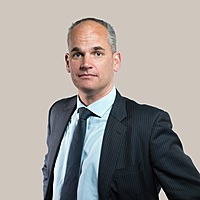Identifying the next climate change leaders
Not every decarbonisation stock is an opportunity, nor is every company a likely shot at sticking around through the next decade and beyond. Here at Munro Partners, we aim not to create an "ESG" fund but rather to create a portfolio of climate winners that help enable the decarbonisation of the planet.
The world has – to put it lightly – a serious problem. Where we believe we can contribute is in setting up a fund that really just focuses on this one thematic opportunity. Because the problem is so serious and will take such a long time to mend, the portfolio is long only and always fully invested.
So why do we think this is such a good opportunity today, and why did we set up this standalone thematic front? In this edition of Fund in Focus, we'll look at this multi-trillion dollar challenge and delve into how we tackle the investment opportunities in this space.
Edited transcript
Hi, my name's Nick Griffin. I'm the CIO here at Munro Partners, and today I'm here to talk to you about the Munro Climate Change Leaders Fund.
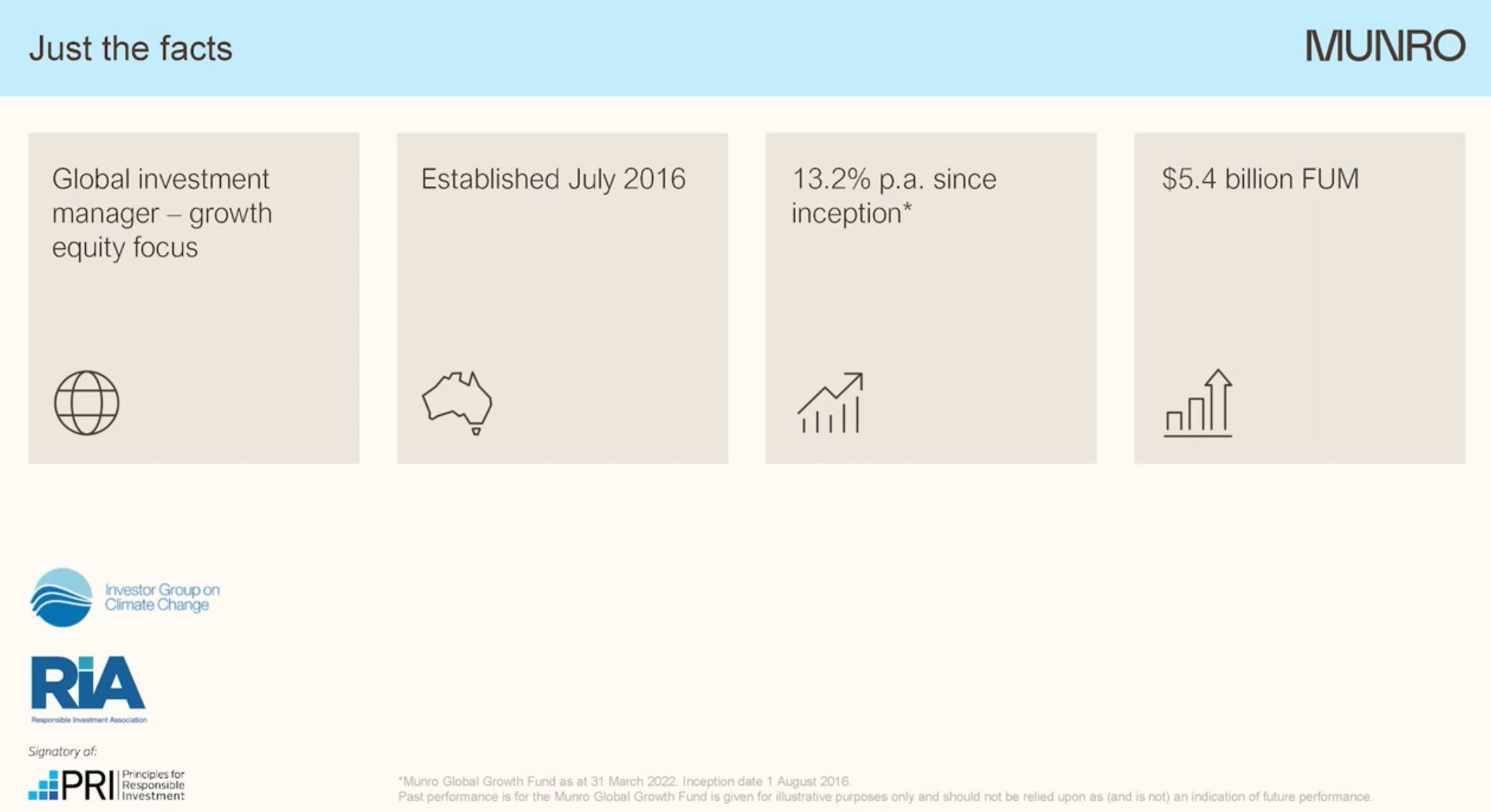
So quickly by way of background, Munro Partners is a global growth equity manager based in Melbourne, Australia. We set the business up in 2016 to be your global growth investor, to give your a way to access some of the world's great growth companies around the world.
So many of you may be familiar with our core global growth products, be it the Munro Global Growth Fund or the Munro Concentrated Global Growth Fund. And these are our global equity products where we really try to exit is all the great global growth companies in the world today. But what I'm actually here to talk to you about today is the Munro Partners Climate Change Leaders Fund.
This is a new product we've launched, and it really is just trying to focus on one of the structural changes we see in the world, and that's the structural change to decarbonize the planet and really to identify the great growth companies in the world that are going to actually help enable this decarbonisation.
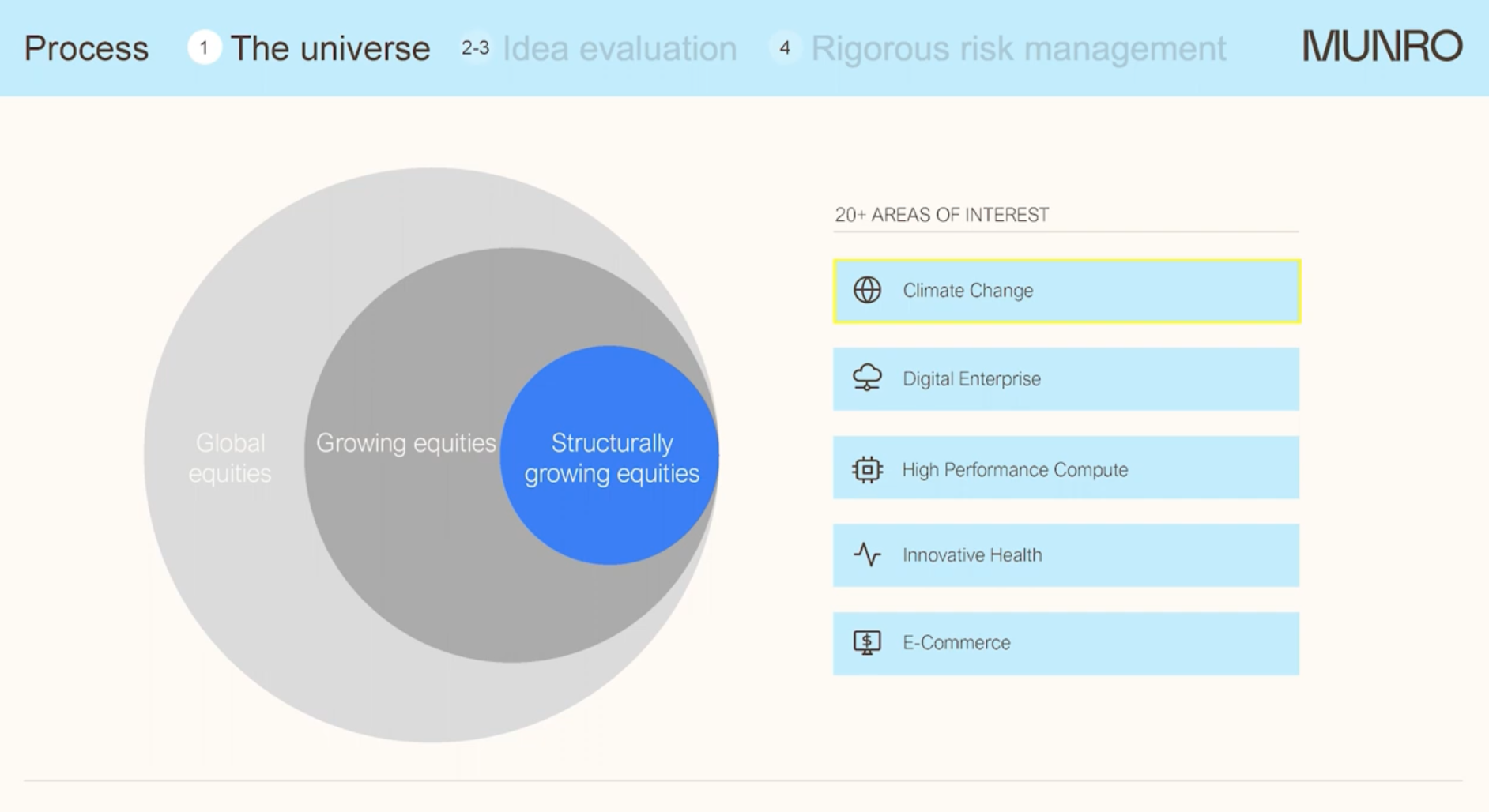
So put quite simply, just to maybe talk about the genesis or the background of the fund, Munro Partners has a 15-year investment process of identifying great global growth companies. How we've done this for a very long period of time is we've basically taken the global equity universe, which we think is roughly 35,000 stocks. We've then distilled that down to the companies that we think can grow. But most of those companies are growing really because of macroeconomic factors or because of cyclical factors, and that's something that we have a view on, but we don't have an actually have an edge.
What we're really trying to focus on is the little bubble in the middle - circular growing companies that we think can grow somewhat regardless of the cycle. And we split these companies into different areas of interest.
So for over a decade now, we've been really focused on things like e-commerce or cloud computing or healthcare, because all of these areas, as we now know, have created these great structural S-curves of adoption, and these huge S-curves having created these great earnings growth opportunities, and these earnings growth opportunities have ultimately equaled share price opportunities. So that's really our simplistic way of thinking about the world.
For years now, we've identified things like Amazon nearly a decade ago, MasterCard a decade ago, or even Google more than a decade ago, and more recently semiconductor companies like ASML and Nvidia.
And all of them really were identified by these different areas of structural growth, and these different areas of structural growth, as I said, equal earnings growth and equal share price growth. The one we're here to talk to you about today is one area of interest being climate change, and the reason why we're talking about this is because we think this is the next big structural opportunity. And so excited are we about this next big structural opportunity that we've set up a standalone fund, the Munro Partners Climate Change Leaders Fund. So what I'm going to do is just talk about the fund very briefly, and then also talk about why we think this is the next big structural opportunity.
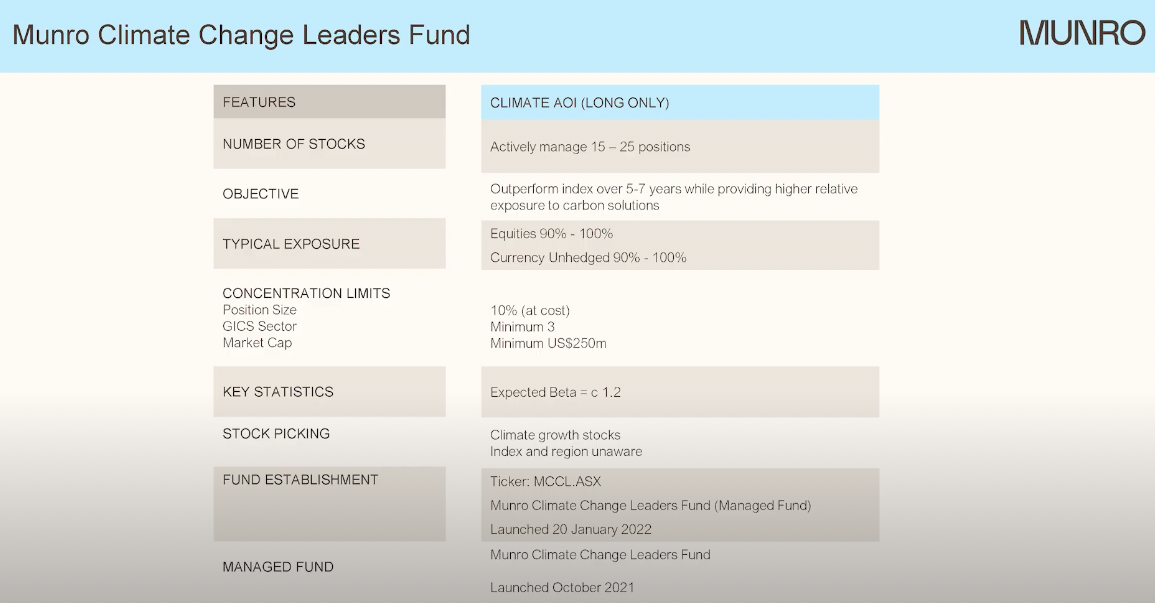
So first, really simply, what is the Munro Partners Climate Change Leaders Fund? Most importantly, it's not meant to be an ESG fund. Yes, we do look at ESG factors when we look at every company here at Munro Partners, but in this fund, what we're actually looking for is a portfolio of climate winners that help enable the decarbonisation of the planet, and that keyword is enable.
Put simply we think the world has a big problem, i.e. it needs to decarbonise. The companies that can help enable that decarbonisation look like great investment opportunities.
From our point of view, what we're trying to do is set up a fund that really just focuses on this one thematic opportunity. You should probably look at it as a thematic fund, at this one opportunity.
When we were constructing the fund, we thought very specifically about that. So we didn't want this to be a replacement for your global equity exposure. We wanted it to be really a way for you to prosecute that thematic opportunity. So it is a very concentrated fund. We're running just 15 to 25 positions here. The fund is a long-only fund, most importantly, so it's fully invested at all times. It is fully currency unhedged. And most importantly, it trades on the Australian stock exchange under the code MCCL. So the simple way for you, the viewer, to think about this, is that if you buy a share in MCCL today, then tomorrow you're going to wake up and own between 15 and 25 of what we think are the great growth companies in the world that are going to help enable the decarbonization of the planet.
We think this is a great opportunity for them because they're solving a big problem, but also importantly, your dollars going into this fund will help them solve that problem. So if you care passionately about this cause, then it's obviously a good place to put your money to help create that win-win circle that capitalism can create when capital is allocated to the right places.
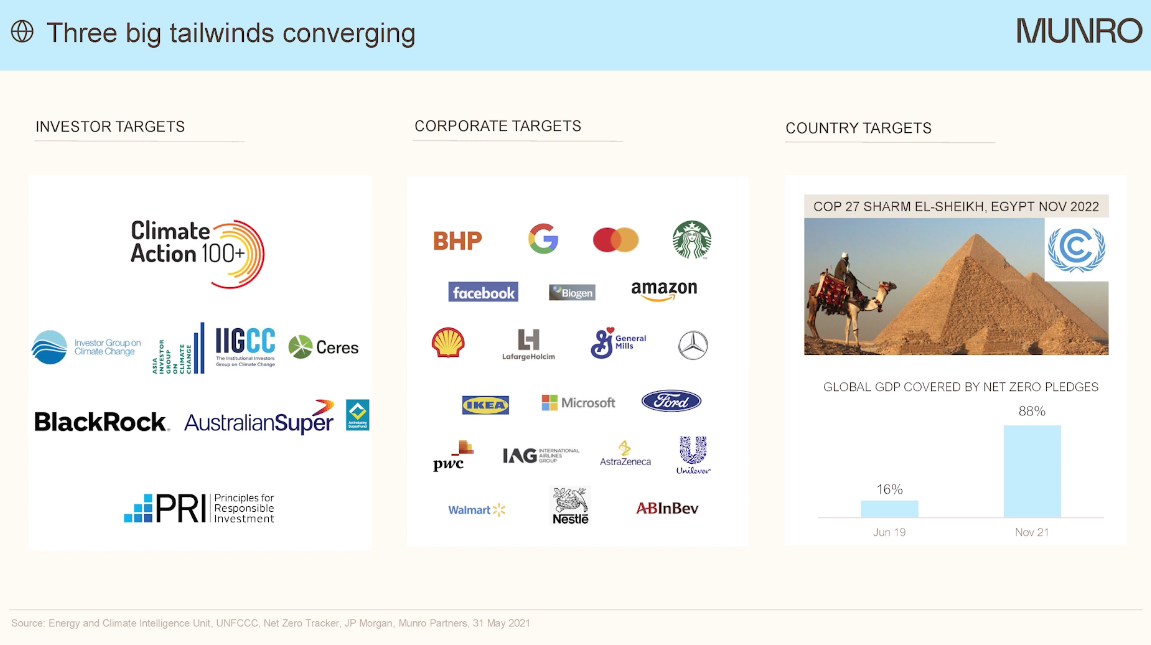
So why do we think this is such a good opportunity today, and why did we set up this standalone thematic front? It's because we ultimately think we've reached this tipping point in decarbonization. As we sit here today, we see major investors around the world effectively setting carbon-neutral portfolios.
Those carbon-neutral portfolios, whether it's Australian Super or BlackRock are joining groups like the Investor Group on Climate Change, and ultimately pushing their companies to decarbonise. They're pushing their companies to decarbonise because you, the investor, care about it, and because their constituents and stakeholders care about that.
This is the big shift we've seen in the last three years - every corporate in the world is essentially setting a net-zero target. They're setting a net-zero target to decarbonise their company.
The best example here in Australia would be BHP. BHP has a net-zero target by 2050. They publish a sustainability report. It's audited by EY. And in that, they effectively prove over time that they will get to that net-zero target. So what we see now is most of the major Fortune 2000 effectively committing to science-based targets, committing to the Task Force for Climate Change Reporting, and ultimately committing to decarbonize their companies.
We think this is the source of a great opportunity.
And on top of that, lastly, you're seeing countries providing the regulatory framework to enable these companies to do that, and that's been driven very much by these COP26, COP27 climate meetings that are happening every year. So that creates what we think is the opportunity or the total addressable market.
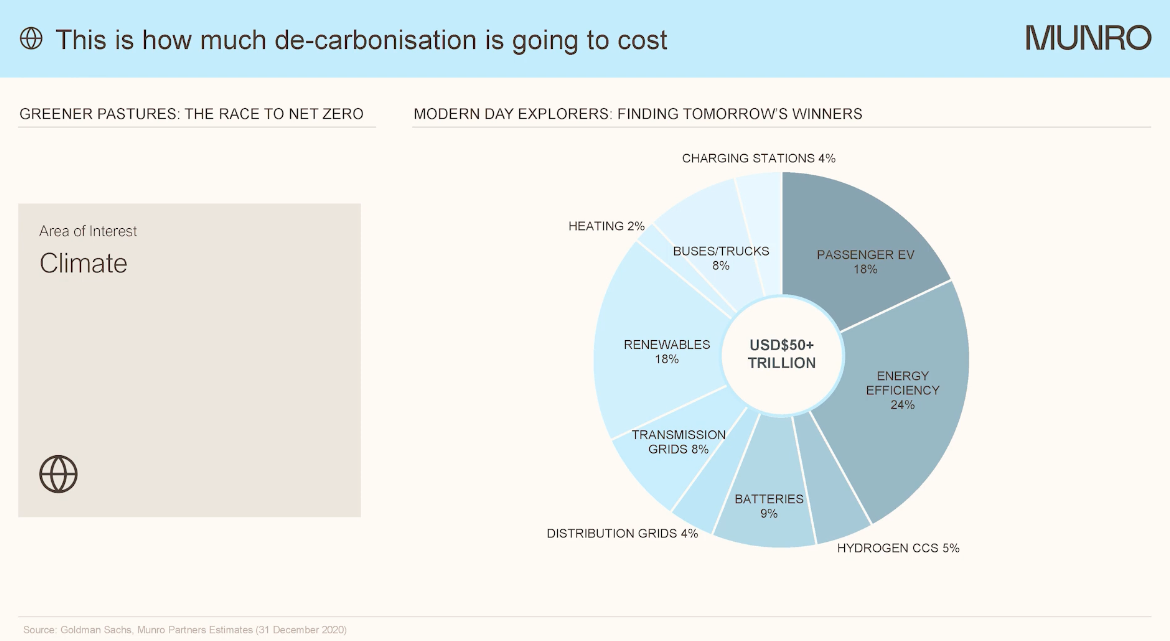
This is some data from the European Bank of Reconstruction, but they think it's going to cost roughly $50 trillion to decarbonize the planet. We've seen numbers as high as $100 trillion. This just shows you a good sub-sector of where the money will be spent. So while the obvious areas like renewable energy and passenger electric vehicles are the obvious place to spend the money, it's also important to flag that it's a very diverse opportunity. It goes to areas like energy efficiency or battery technology or transmission grids also.
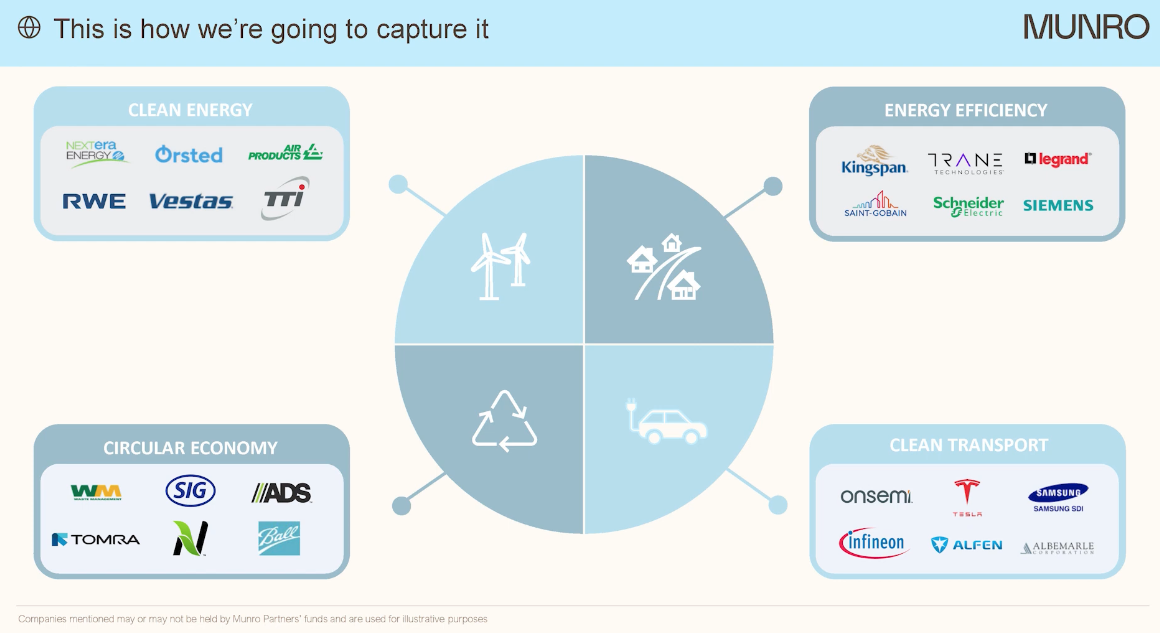
So this is how we've basically segmented our portfolio, or segmented this fund, to try and capitalise on this opportunity. What we've said is we see $50 trillion of capex that's going to be spent to help decarbonize the planet, so that's ultimately going to equal $50 trillion in revenues to the companies that help enable that decarbonization.
And what we've done is we've split it into these four quadrants, or sub-sectors where we see companies that could win. The first and most obvious is on the top left, and that's clean energy. Clearly, we need to move to electrify the economy, and that electricity needs to be driven by renewable sources. That's going to benefit renewable energy developers like Nexterra, but it's also going to help benefit renewable OEMs like Vestas, which is the world's largest wind turbine manufacturer. These are companies that are really at the forefront of that renewable energy transformation.
The second big area on the right is probably less well known, it's energy efficiency. So the other simple way to get to net zero is to quite simply consume less electricity or consume less power. This is where companies, traditional industrial companies have a role to play, like Kingspan in insulation, Schneider Electric in electric switches, or Trane Technologies in heating, ventilation, and cooling. Quite simply, all of these companies are industrial companies that are now benefiting from a huge as companies try to make their buildings net zero, or to lower the emission footprint of their buildings.
The third area on the bottom right there is probably the one we're almost familiar with, which is clean transport. Clearly we need to move the passenger electric vehicle to electric and we need to move the truck fleet to electric. This has obviously been a huge opportunity for our first climate champion in the world today, being Tesla, but there's also most importantly a big supply chain behind that. And the last area is circular economy. These are simply the companies that benefit from recycling, the packaging companies that are going to help us really solve this problem that the world doesn't have the resources to continue to grow at the rate it's growing at. So these are packaging companies, these are recycling companies, and most important, the agriculture companies that we think has a big role to play here.
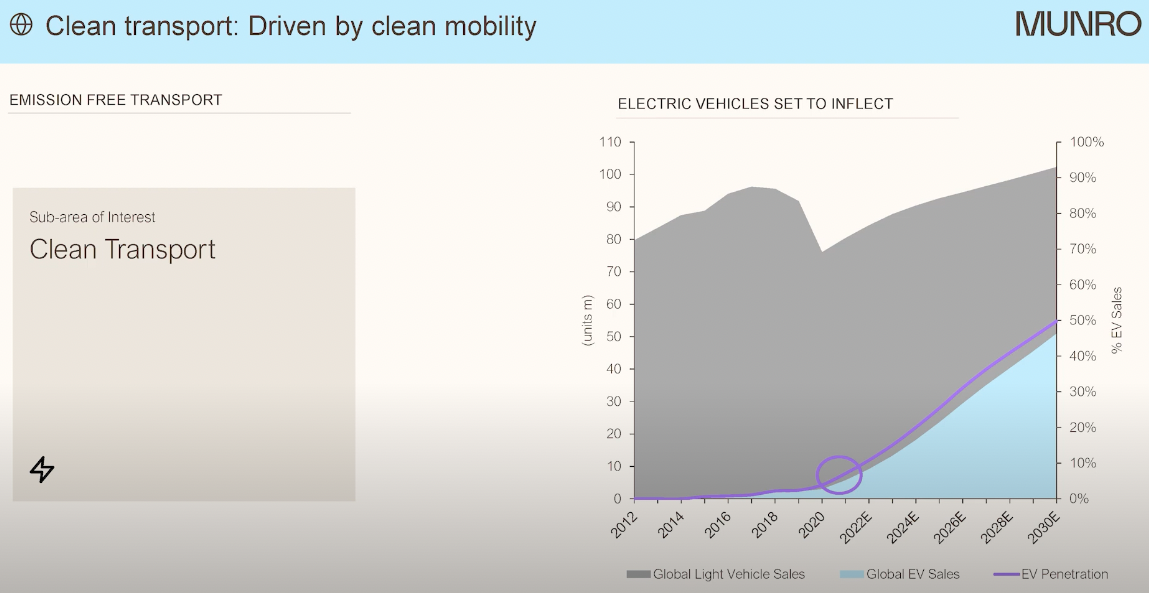
And maybe just to dive into one of these areas, just to identify the opportunity we're talking about here. This is clean transport. The car market today really sets up as the smartphone market did over a decade ago. We are selling roughly 90 million cars a year. The car market's probably not going to grow, but we know that electric cars or this new technology are going to take share. Only 5% of all cars today, probably growing to 40% over time.
And as I said, this does set up, like the smartphone, digital advertising or the eCommerce opportunity. You have a traditional market where a new technology's going to come along and take share.
From our point of view, one of the big opportunities here is semiconductors. An internal combustion engine has only roughly $375 worth of semiconductor content in it, but a fully electric autonomous car has roughly $1,600 of semiconductor content in it. Semiconductors are the muscle in a muscle car that is electric. It's no longer a V12 engine. It is power semis that are ultimately driving the battery to torque to get you that wonderful acceleration.
From our point of view, a great opportunity here is Onsemi Conductor. A simple power semiconductor supplier, one of the leaders in the industry today.
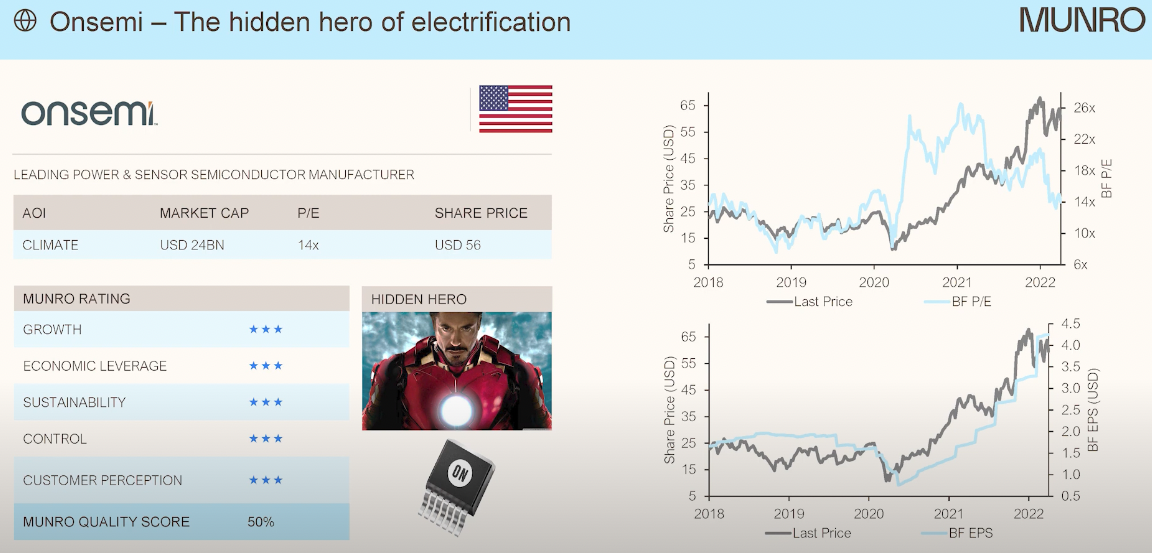
You can see on the bottom right there, that is its blended forward earnings per share. You can see the earnings upgrades that are coming through as this structural opportunity starts to become clear. Yet, it's roughly 14 times earnings today. So from that point of view, this is just a really good simple of how the industry's going to change and how this is going to benefit companies that have previously been quite simply industrial companies that are now going to become structural champions as the efforts continue to decarbonise the planet.
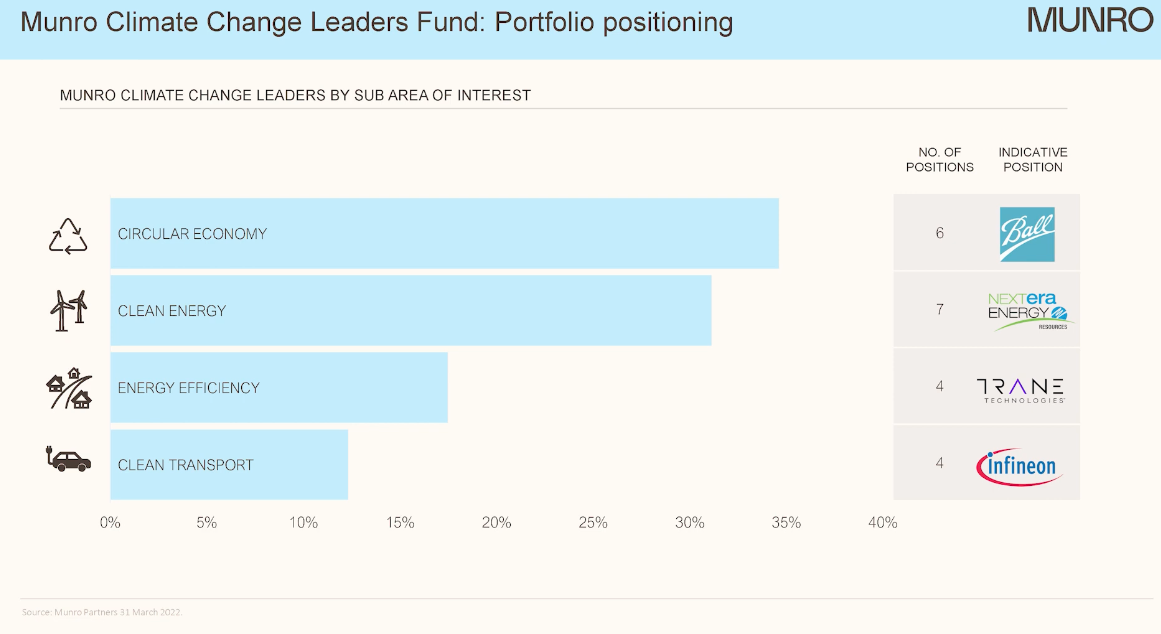
Importantly, Onsemi is just one idea in the climate fund today. What we're showing on this slide is really just how we tried to fund amongst these four sub-sectors that we're looking at. What we're showing here is the circular economy is roughly 35% of the fund today, clean energy is 30%, energy efficiency is 16%, and clean transport is 10%.
And on the far right, we're showing you some of the indicative positions that we're looking at here, be it Ball Corp, Trane Technologies, or Infineon. So from our point of view, what we're trying to do here is provide you with a diversified portfolio of climate leaders that are going to help enable the decarbonization of the planet.
All of these companies trade at a mixture of valuations. You can actually build a portfolio, if you want here, of zero revenue companies. We've not done that. This portfolio actually trades at the market multiple today, and we'll trade, roughly, we think, an EBITDA of around 1.2.
So what we think over time here is across our universe and across these sub-sectors, we can build an enduring portfolio of companies that enable the decarbonisation of the planet, ultimately benefit from the earnings growth that's going to come from that, and then drive performance for the fund over the medium term.
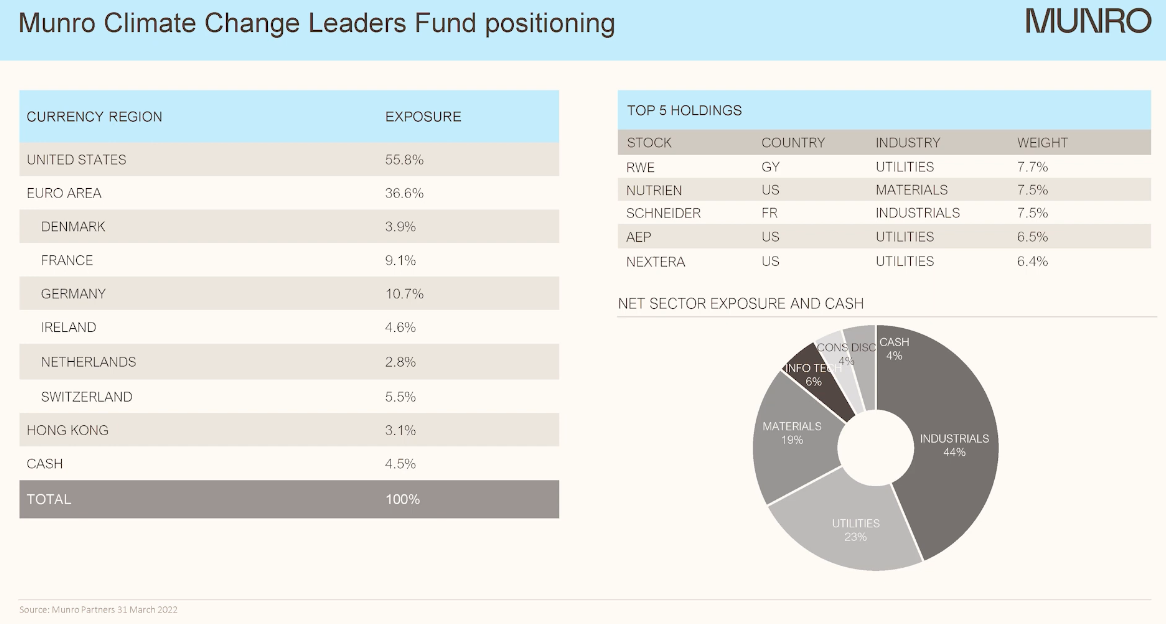
On this last slide here, we're showing it from another different point of view. This is the fund as it was at the end of March, 2022. And quite simply just shows you how this fund over-indexes to industrials or materials or utilities.
And most importantly, it is not a technology opportunity. It is a physical opportunity, the climate opportunity, and these are the areas where we do see the structural growth in the months and years ahead.
This is just the fund as it was at the end of March. Please use our website and any of our other materials to continue to keep track of the fund. And ultimately we look forward to come back and updating you over the many years into the future as we think this opportunity will play out, will ultimately drive us towards these new, great climate champions that we're looking for in this product. Thanks very much for listening.
Access to a $50 trillion opportunity
The Munro Climate Change Leaders Fund is focused on creating a portfolio of climate winners that help enable the decarbonisation of the planet – those companies that are best positioned to champion and win from this structural change. Find out more below, or by visit our website.


3 topics
1 stock mentioned
2 funds mentioned

